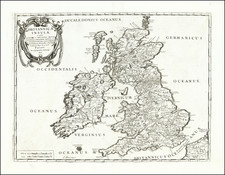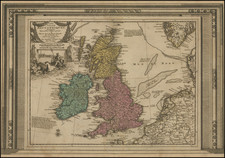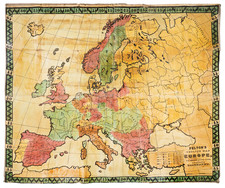Rare and very odd projection of the world, with Britain at the center, published by John Andrews in London.
This is, by all accounts, one of the strangest cartographic conceptions of its time. The map was part of John Andrews's Historical Atlas of England, which was issued sheet by sheet over nearly the entire decade of the 1790s.
A work of extreme rarity, Walter Goffart in his study of historic atlases located only a single example, which was apparently divided between two British Libraries, noting that "of its 12 sheets, the British Library copy lacks 3, very important ones; they are at Oxford."
As noted by Goffart in describing both Andrews's atlas and the present map in particular
Andrews's atlas is the oddest and in some sense the least historical work we have encountered, yet not so strange as to be disregarded. The Weimar journal Allgemeine geographische Ephemeriden greeted the early sheets with praise and enthusiasm, even though the maps espoused Philippe Buache's notions of physical geography, with which the viewer disagreed. Later issues out of Weimar record growing disillusionment, motivated by the slow pace of publication and particularly the map of the English Fisheries and spas. The reviewer was still waiting for history.
. . . Andrews had an eclectic conception of the past. . . . Continental historical atlases had no influence on him. He unwittingly foreshadowed a distant future of dominant thematic maps and appears to subscribe to an histoire (presque) totale, extending from the physical formation of England to its modern deaneries and healing waters, not foretting the Saxon and Norman invasions.
Andrews is most original, even eccentric, in a map that contains historical informaion, yet is well designed to disconcert readers of history. Polar projections are familiar for certain kinds of information and had long been drawn. The same does not hold for a projection in which London takes the place of a pole: "Political, Historical, Astronomical and Commercial, Chart of Europe. To Shew relatively the Situation of Places by the Rays of the Sun, the Rumb of the Wind and the hours of the Day, from the Meridian to the Parallel of London, on which are delineated the Zones and Climes with the tracks of the Carthaginians, Phoenicians, Romans, Saxons, Danes & Swedes, with rectiline distance in circles of 100 miles each." The map, an exceptionally large foldout, radiiates out of London; it reached the North Pole and the Sahara and includes part of Greece and the Black Sea, as well as Scandinavia and Iceland. Much navigational information is recorded, and many localities are noted, including negligible ones in Iceland. The various tracks -- discrete, labeld lines -- are Andrews's bow to conventional historical events. The lines trace the more or less permanent visitors to Britain, some as tin merchants, others as raiders and settlers; Saxons are distinguished from Anglo-Saxons. The unannounced, least expected track is of Stuart Pretender, both coming and going in 1745. Much is fitted into this large map. Andrews outdid himself in striving to couple the cartography of navigation to some at least of the early navigators who reache British Shores.
OCLC locates a copy of this map at the University of Oxford.









![[Rare Complete Example with Game Pieces] Grand Circuit Des Capitales. Collection Concours Du Chocolat Menier](https://storage.googleapis.com/raremaps/img/small/70922rd.jpg)



![Carte generale de l'Empire romain [des Sarrasins]](https://storage.googleapis.com/raremaps/img/small/82000.jpg)
